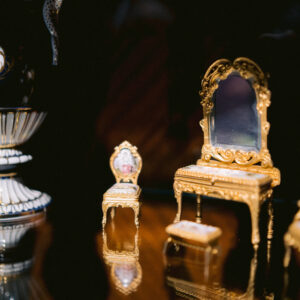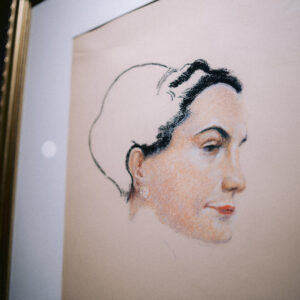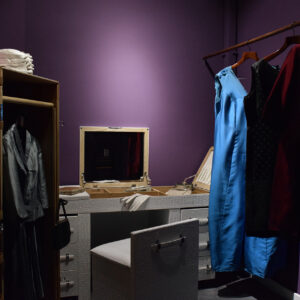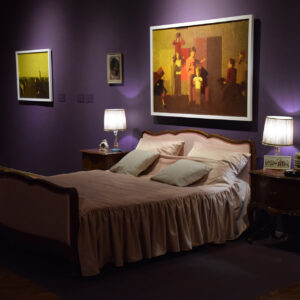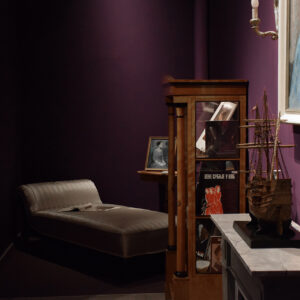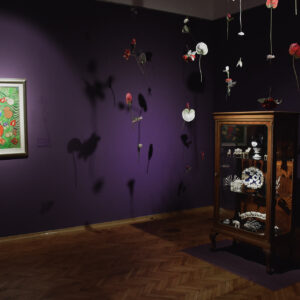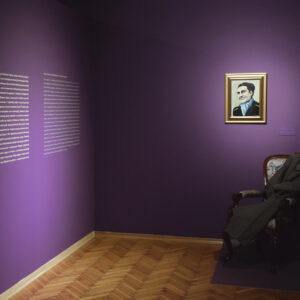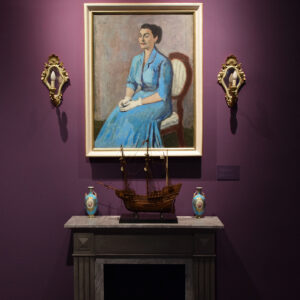While being respectful of the concept of Jovanka’s “original” exhibition, we decided to present to the audience everything as exactly as Jovanka imagined and arranged it.
About heroine that Jovanka Broz was, the importance of the exhibition about her and plans for this year we talked with Tijana Palkovljević Bugarski, director of the Matica Srpska Gallery the director of the Museum of Yugoslavia and Neda Knežević.
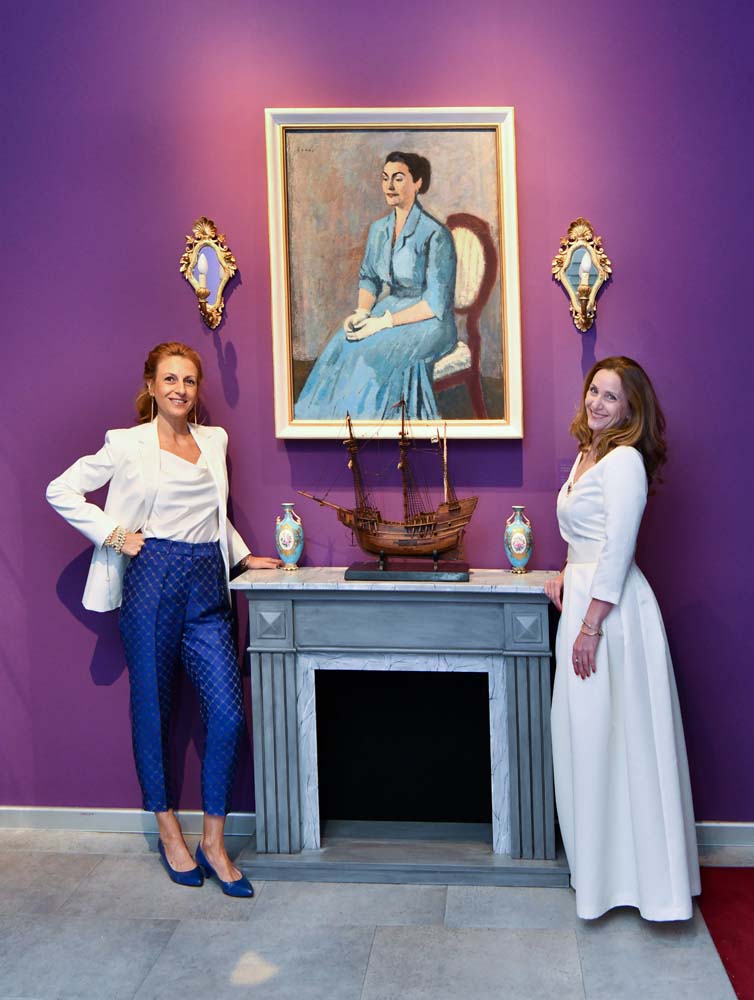
The exhibition titled “Partisan and Fragonard – Jovanka Broz’s Collection of Paintings” was staged under the auspices of the Heroines programme of the 2022 European Capital of Culture project. What kind of heroine was Jovanka Broz?
Tijana: If you were to ask each of us “Who really was Jovanka Broz?”, you would be given a myriad of different answers. The fact that Jovanka became a myth often comes as a result of not having enough historical data about someone or something or them being insufficiently researched. As a partisan, and then the first lady of socialist Yugoslavia, her role and importance in creating the image of Yugoslavia in the world (and the region) was substantial. Everything that has to do with Jovanka Broz is inseparable from the history of a country, its society, politics, culture, fashion and other aspects of everyday life. In that sense, as a personification of socialist Yugoslavia, Jovanka Broz is truly a heroine and a sacrosanct symbol of an epoch.
Created in cooperation with the Matica Srpska Gallery and the Museum of Yugoslavia, the exhibition “Partisan and Fragonard – Jovanka Broz’s Collection of Paintings” showcases a number of her personal items. How hard was it to collect and preserve all these things?
Neda: After the death of Jovanka Broz, the state commission found a large number of cases in her house. The curators of the Museum of Yugoslavia were members of the state commission in 2016, and their task was to determine, as per the existing documentation, which of the things and objects found in the villa belonged to the Museum, that is, the former Josip Broz Tito Memorial Centre. Everything that used to be part of the residence of Josip Broz, as well as all the gifts that Tito and Jovanka had received, has been recorded and made a part of the museum. Jovanka had a special emotional relationship with the works of art, furniture and objects of applied art, which were transferred from the residence to the villa where she lived since 1980. The villa’s ambience was reminiscent of the residence in terms of the layout of paintings, decorative objects and furniture, which made up her immediate surroundings until the last day. Jovanka took great care of her personal items (clothes, accessories), as well as items for everyday use, almost like an art collector.
The exhibition focuses on items that were part of Jovanka Broz’s life out of the limelight for 33 years. The paintings that were taken from the villa were handed over for conservation and restoration to the excellent conservation team of the Matica Srpska Gallery, and subsequently became the subject of this project. Thanks to the professional care and new interpretation of the Museum’s and Gallery’s curators, a small segment of the Museum of Yugoslavia’s abundant collection was thus transformed into an attractive exhibition. The Museum of Yugoslavia and the Matica Srpska Gallery have been developing partnership and inter-institutional cooperation for many years while bringing together professional staff, curators and conservators. Exhibitions and accompanying published material came as a result of this.
How important is this exhibition, that is, the items that Jovanka kept for more than 30 years?
Tijana: All the items showcased at this exhibition were the backdrop to the life of the married couple Broz. They used to decorate the space of their home at 15, Užička Street, which Jovanka then transferred to the villa that was given to her after Tito’s death. This is a small collection of memorabilia, with Jovanka Broz herself being the curator of this unusual collection. The visitors now have a unique opportunity to see for the first time the items and paintings that the Broz family enjoyed, which Jovanka kept for years as a remembrance of the time she considered lost, as well as trying to preserve the memory of certain people and events. While being respectful of the concept of Jovanka’s “original” exhibition, we decided to present to the audience everything as exactly as Jovanka imagined and arranged it. We recreated certain segments and thus tried to breathe a new lease of life into the first lady’s collection, placing it in its original context. It seemed to us that this was the best way for us to save from oblivion a space that could have been lost forever, while, at the same time, telling a story about it to the visitors’ delight
Does the exhibition reflect the social and artistic circumstances of the former Yugoslavia?
Neda: The 1960s were considered the golden years, an era with a very lively art scene, when new museums and galleries opened. In the 1970s, art colonies emerged, and thus artistic events became more accessible to a larger audience.
The exhibition focuses on items that were part of Jovanka Broz’s life out of the limelight for 33 years.
The Broz couple, especially Tito, posed for many artists and knew some of them personally. Artwork that was later given as state gifts or was displayed at the residence was purchased from artists. Josip Broz was a patron of several cultural and artistic events. Thanks to that, Jovanka and Tito were recognized as admirers of art who were often gifted artwork that was incorporated into the Museum of Yugoslavia’s art collection.
What other public figures are featured in the Heroines programme?
Tijana: As a programme arch, the Heroines is extremely diverse and offers the audience abundant content. In addition to Jovanka Broz’s collection of paintings, the visitors can also see the paintings of Serbian painters from the first half of the 20th century in the Pavlje Beljanski Memorial Collection. The Heroines progamme features paintings by Nadežda Petrović, Liza Križanić, Zora Petrović, Leposava Pavlović, Ljubica Sokić, Vidosava Kovačević and Milica Zorić. The Museum of Contemporary Art of Vojvodina showcases the works by European artists from the second half of the 20th century in the exhibition “Feminist Avant-Garde of the 1970’s”. There is also the artwork from the Verbund Collection (based in Vienna), while the Museum of Vojvodina has an exhibition entitled “Scarves as a Cultural Signifier”. In parallel with these diverse museum programmes and exhibitions that in various ways represent the place, role and contribution of women in art, there are numerous concerts, theatre and ballet performances that promote women’s creativity.
We are extremely proud of the fact that we put together the “Partisan and Fragonard – Jovanka Broz’s Collection of Paintings” in collaboration with the Museum of Yugoslavia, our longtime partner and institution with which we have exceptional cooperation. We are also proud of presenting this exhibition and a part of so far unseen cultural heritage kept at Serbian museums in synergy with the public.
What can we deduce about Jovanka Broz from the exhibition artefacts?
Neda: Based on the exhibited paintings, furniture, objects of applied art, personal items and photographs, we can reconstruct details from Jovanka’s life and form an image of the time in which she lived.
Everything that has to do with Jovanka Broz is inseparable from the history of a country, its society, politics, culture, fashion and other aspects of everyday life.
Courtesy of Mrs Svetlana Aleksić, wife of Jovanka’s nephew, who donated private items and personal belongings of Jovanka Broz, the gallery space took on the character of the original environment where these works of art were displayed, while the exhibition gained an additional emotional dimension. From the variety of exhibited objects, we can sense a constant duality, because Jovanka was, at the same time, the first lady and a partisan, housewife and worker, emancipated and traditional. By entering this imaginary museum, we wanted the visitors to get a clear picture of who she was.
What are the Matica Srpska Gallery’s plans and future programmes, when it comes to Novi Sad, under the auspices of the 2022 European Capital of Culture project?
Tijana: Throughout the summer, people will have the opportunity to enjoy the exhibition “Partisan and Fragonard – Jovanka Broz’s Collection of Paintings” with numerous accompanying programmes that will last until early September. On July 8, we will open the exhibition “Parallels Novi Sad/Timisoara”, which will present the artwork from two museums – Novi Sad and Timisoara – merged into a single exhibition under the auspices of the 2022 European Capital of Culture project. By drawing different parallels between the collections, artists and artwork, we will highlight the unity of the European art space. Finally, on October 7, we will stage a large-scale retrospective exhibition about Uroš Predić and then the Uroš Predić programme in order to get a wider public better acquainted with the work of this famous national and European painter. Children will be able to learn about Predić through specially adapted programmes and publications, younger people will learn about him via comic books, while people with disabilities will enjoy Predić’s artwork with the help of specially designed content. In this way, we will highlight the creative work of one of the most important Serbian painters in a new, contemporary and innovative way, while at the same time, showing how open are 21st-century museums to local communities and all segments of the public.
Is the Museum of Yugoslavia planning on staging a similar exhibition in the coming period?
Neda: On the tenth anniversary of Jovanka Broz’s death and the centenary of her birth, we plan to add items from other collections to this exhibition. In that way, the character of the first lady will be seen through a multidisciplinary approach. So far, nobody has published a comprehensive biography or historiographical study on Jovanka Broz, nor has her role in Yugoslav politics been thoroughly researched. Most of the information and articles about her life came from journalists. The story of Jovanka Broz will definitely be told only when the story of Josip Broz is told.
